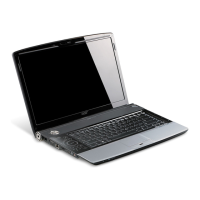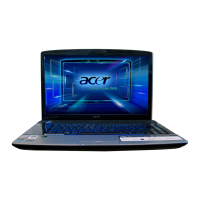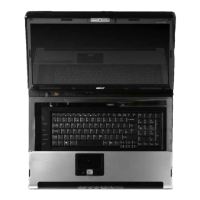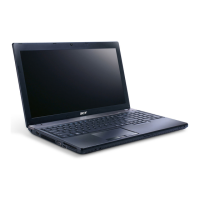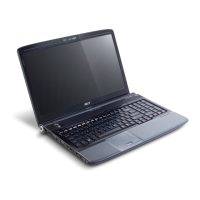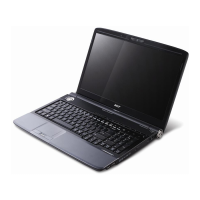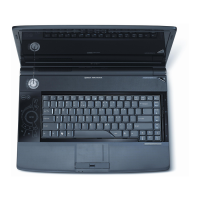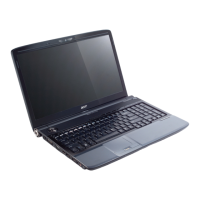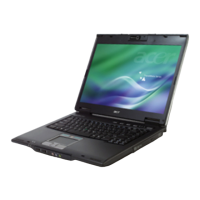
Do you have a question about the Acer 6460 6263 - TravelMate and is the answer not in the manual?
Read instructions carefully, keep document for future reference, and follow warnings on the device.
Covers warnings about water, unstable surfaces, ventilation, electrical hazards, and vibration.
Guidelines for using the power adapter, avoiding overloads, and proper grounding for safety.
Instructions for maintenance, including when to contact after-sales service for repairs.
Information on replacing the lithium battery, safety warnings for handling, and proper disposal.
Safety guidelines for using telephone lines, especially during thunderstorms.
Keep small components away from young children for safety.
Turn off wireless transmission devices in specific environments for safety.
Information on potential interference with medical devices like pacemakers.
RF signals may affect vehicle electronic systems; consult manufacturer for details.
Turn off the device in environments with explosion risks, like fuel stations.
Warning: This device cannot be used for emergency calls; use a mobile phone instead.
Recycle electronic devices properly to minimize pollution and protect the environment.
Adjust monitor angle, use footrest, or elevate seating for maximum comfort.
Suggestions to reduce eye strain from prolonged computer use.
Tips for ergonomic posture, breaks, stretching, and breathing fresh air.
Covers general maintenance, cleaning, and essential usage tips for the computer.
Instructions on how to power the computer on, power it off, and manage sleep/hibernate modes.
Covers AC adapter and battery care for optimal performance and longevity.
Procedures for cleaning the computer and laptop using a soft, damp cloth.
Initializes the Empowering Technology password for Acer eLock and eRecovery Management.
Connects quickly and easily to wired and wireless networks in various locations.
Configures power management options with predefined and customizable profiles.
Projects the computer display onto an external device or projector.
Encrypts files to protect data from unauthorized access using passwords.
Locks removable storage, optical drives, or diskette drives for data security.
Creates, backs up, and restores system configurations and applications.
Inspects hardware specifications, sets BIOS passwords, and modifies initialization options.
Identifies components visible on the front of the notebook.
Identifies indicators and ports on the front when the notebook is closed.
Identifies ports and slots on the left side of the notebook.
Identifies the optical drive and USB ports on the right side.
Identifies ports such as S-video, modem, Ethernet, and VGA on the rear.
Identifies battery bay, hard drive bay, and other components on the base.
Instructions on using the FineTrack pointing device and its click buttons.
Guidelines for moving the cursor and using touchpad buttons for selection.
Explains the function of Caps Lock, Num Lock, and Scroll Lock keys.
Details functions of the Windows key and its combinations.
Explains special function keys (Fn) for system controls like display and volume.
Easy adjustment of computer volume using dedicated buttons.
Manages multiple monitor setups for enhanced productivity.
Defines and configures the four quick launch buttons on the keyboard.
Secures the notebook using a Kensington compatible security slot.
Protects data by parking hard drive heads and includes anti-theft alarm.
Defines roles within the Security Platform based on Windows user accounts.
Steps for installing and administering the Acer Security Platform.
Levels of authentication for using security functions, including password and extended methods.
Guidelines for creating and managing passwords and passphrases for security.
Covers international warranty service and how to use the ITW passport.
Information to prepare before contacting Acer for service.
Features of the battery, including technology and low battery warnings.
Recommendations to extend battery life and improve recharge efficiency.
Procedure for initial charging and discharging of a new battery.
Step-by-step guide for inserting and removing the notebook battery.
Instructions for charging the battery, including fast charging options.
How to view the current battery level using the Windows taskbar.
Action recommendations when the low battery warning appears.
Steps to disconnect accessories and prepare the notebook for transit.
Guidelines for moving the computer between your office and home.
Essential items to pack for travel, including adapters and spare batteries.
Specific advice for international travel, including voltage and telecom compatibility.
Details on connecting peripherals like modems, networks, USB, and IEEE 1394 ports.
Instructions for inserting a DVD and playing movies, including zone code information.
Steps to create full or incremental system backup images.
How to burn system images or application backups onto CD or DVD.
Procedures to restore the system from factory image or previous backups.
Solutions for common problems and error messages displayed on screen.
List of system error messages and recommended corrective actions.
Compliance with FCC rules for radio frequency emissions and interference.
Statement of compliance with essential requirements of EU directives.
Regulatory information for wireless and Bluetooth devices.
Compliance with Canadian regulations for low power radio devices.

